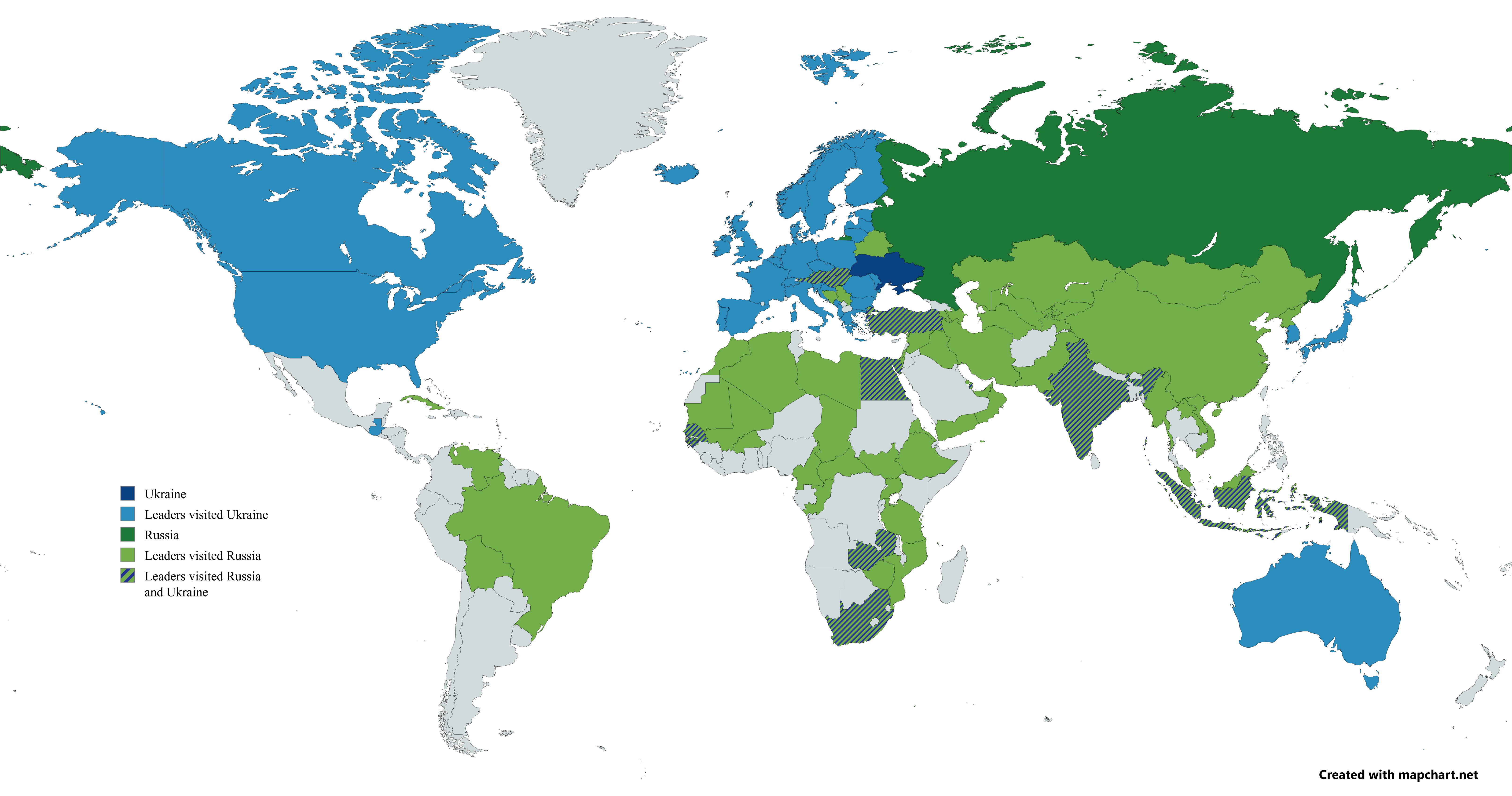Map of Foreign Leaders' Visits to Russia and Ukraine


David Chen
Data Visualization Specialist
David Chen is an expert in transforming complex geographic datasets into compelling visual narratives. He combines his background in computer science ...
Geographic Analysis
What This Map Shows
This map visually represents the visits of foreign leaders to Russia and Ukraine following the 2022 Russian invasion of Ukraine. Each marker indicates a country’s leader who traveled to either nation during this ongoing conflict, highlighting the geopolitical interactions and diplomatic efforts that have emerged in response to the war. As the world watches this conflict unfold, these visits signify diplomatic relationships, political stances, and international alliances.
Deep Dive into Diplomatic Engagements
The phenomenon of foreign leaders visiting Russia and Ukraine post-invasion is more than a simple record of travel; it is an intricate web of diplomacy, support, and international relations. In the wake of the invasion, countries have been navigating a complex landscape where their actions and decisions can sway global perceptions and influence the course of the conflict.
Countries like the United States, Canada, and several European nations have shown a heightened level of engagement with Ukraine, often sending leaders to demonstrate solidarity. These visits are not merely symbolic; they often come with commitments of military aid, financial support, or humanitarian assistance. For example, U.S. President Joe Biden's administration has been active in rallying support for Ukraine, which is evident in high-profile visits from U.S. officials and allies to Kyiv. These acts underscore the commitment of Western nations to support Ukraine against Russian aggression.
Conversely, Russia has also hosted several leaders, albeit from nations that are more aligned with its worldview or have strategic interests in maintaining relations with Moscow. For instance, leaders from countries like Belarus and some Central Asian states have made visits that reinforce economic and political ties with Russia. This aspect of the map illustrates a stark divide in international relations, where the lines of support are drawn, and allegiances are tested.
Interestingly, these visits often reflect broader trends in global politics. For example, nations opting to visit Ukraine often signify a shift toward liberal democratic values and a stand against authoritarianism. On the other hand, those visiting Russia may indicate a reluctance to align with Western policies or an interest in maintaining regional influence.
The geopolitical landscape is further complicated by public opinion, sanctions, and economic considerations. Countries that visit Ukraine often face domestic pressures to support democracy and human rights, while those visiting Russia navigate the balance between diplomatic engagement and the risk of backlash from the international community.
Regional Analysis
The map reveals distinct patterns based on geography. In Western Europe, leaders from countries such as Germany, France, and the UK have made multiple visits to Ukraine, reflecting a unified front in support of Kyiv. Interestingly, this region's response has been marked by a collective approach to providing military and humanitarian aid, showcasing a strong European identity in facing external threats.
In contrast, Central Asia and parts of the Middle East demonstrate a different dynamic. Leaders from countries like Kazakhstan and Turkey have visited Russia, often highlighting economic ties and regional stability. Kazakhstan, for instance, has been cautious in its approach, balancing its historical ties with Russia while also considering its relationship with the West.
Furthermore, Africa and Latin America present a mixed response. Some leaders have visited both nations, attempting to assert their countries' positions as neutral mediators in the conflict. This dual engagement reflects a nuanced understanding of global politics, where countries are trying to navigate their own interests amid a conflict that has far-reaching implications.
Significance and Impact
Understanding the significance of these visits is crucial in the current geopolitical climate. They are not just about showing support or allegiance; they reflect broader themes of international relations, security, and the fight for democracy. The implications of these diplomatic engagements extend beyond the immediate context of the conflict—they shape alliances and create new geopolitical realities.
Moreover, as countries reassess their foreign policies, the map serves as a reminder of the shifting nature of power dynamics in the 21st century. The ongoing conflict may lead to a reconfiguration of alliances that could redefine global politics for years to come. As nations face the consequences of their engagements, including sanctions, shifts in public opinion, and internal pressures, the future of international relations remains uncertain yet pivotal.
In conclusion, the map of foreign leaders' visits to Russia and Ukraine after the 2022 invasion encapsulates much more than travel; it is a reflection of the current state of global diplomacy, highlighting the intricate dance of support, opposition, and strategic navigation that defines our world today.
Visualization Details
- Published
- August 9, 2025
- Views
- 128
Comments
Loading comments...